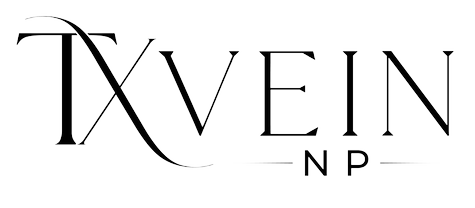- 940-233-8181
- Open 9:00 AM – 5:00 PM
Frequently Asked Questions
Sclerotherapy is a treatment for Spider and Reticular veins that involves injecting a medication called Asclera (Polidocanol) into the veins with a tiny needle. The medication works by irritating the vein lining, causing it to close down and turn into scar tissue. The body eventually reabsorbs this tissue and the vein disappears from the surface of the skin.
Spider veins, or telangiectasias, are damaged visible blood vessels under the skin’s surface. They are red or purple in color and can appear in clusters that resemble spider webs or tree branches.
The main difference between the two is size. Spider veins are red or purple in color and are < 1 mm in diameter. Reticular veins are slightly larger in diameter at 1-3 mm and appear a more Blue/Green color under the skin. Varicose Veins are even larger at>3 mm and usually cause symptoms.
Spider and Reticular veins can occur as a result of weakened valves in larger superficial veins such as the Greater Saphenous and Small Saphenous veins. These weakened valves allow blood to reflux and pool in the legs. The pressure from the pooling blood can lead to reticular and spider veins. Other causes can be related to Hormonal changes, Genetics, connective tissues disorders, and injury or trauma. Certain factors can worsen varicose veins, reticular veins, and spider veins over time, such as standing for long periods of time, family history, obesity, pregnancy, hormone replacement therapy or birth control, and smoking.
One of our highly skilled advanced practice practitioners will be performing the treatment. Sclerotherapy can be challenging and requires excellent clinical skills to assess when sclerotherapy is appropriate and when it is not. Although rare, complications can occur and practitioners are necessary to be able to recognize these complications and manage them appropriately. This is why we require only Physicians, Physician Assistants, and Nurse Practitioners to perform this treatment.
The first step is to book a consultation. There are 2 options: 1) Free consultation and 2) Paid consultation with treatment. Free consultations are for patients who are wanting to learn more about cosmetic sclerotherapy and would like to get their spider veins assessed, but are unsure if they would like to proceed with treatment. Paid consultations are for patient’s who are wanting their spider veins assessed, but are wanting treatment if appropriate. Sessions usually take 30-45 minutes.
It varies from individual to individual. Some people can have successful closure of their spider veins in just 1 session. However, others may require 3-4 sessions to achieve successful closure of the vein. Also, more treatments are usually required when the patient has numerous spider veins or the vein networks are extensive and complicated. There is usually a 60-70% improvement in the appearance of the spider vein after just 1 session! Although, significant improvement is seen in just 4-6 weeks, complete improvement or resolution can take up to 6 months to 1 year.
There is a little sting associated with each injection which lasts a few seconds. Most patients claim that the treatment is much less painful than what they anticipated. After treatment, there can be some tenderness when Reticular veins are treated. However, this usually lasts only a couple of days and resolves relatively quickly with over the counter Tylenol or Advil.
Sclerotherapy has very few, minimal side effects. The most common side effects are discomfort, itching, and bruising. Severe allergic reactions can occur, but are very rare. Alert your provider if you have a history of any severe allergic reactions in the past, or any previous reactions to Polidocanol.
Initially after treatment, the injection sites will appear inflamed. The areas will be red and can have some swelling with raised areas to the injection sites similar to a mosquito bite. There is sometimes some tenderness to the injection sites and there can also be itching to the areas. This usually subsides in the first 1-3 days, although most people have resolution after the first 24 hours. Tylenol or Advil is ok or pain and tenderness if needed and if the itching is unbearable, over the counter Hydrocortisone cream can be applied to the sites. Bruising to the injection sites is also not uncommon and usually resolves in 2-3 weeks. Compression wraps are applied at the end of the session and are left on for 24 hours. Compression socks are recommended for 3-5 days after, which helps to minimize bruising and swelling, and maximize efficacy of the treatment. A follow up appointment is then scheduled for 1-2 weeks.
For the most part, No. There is no “down time” after this treatment. Walking is recommended immediately after the treatment session. Avoid strenuous activity such as high intensity aerobics on hard surfaces, heavy lifting >30 lbs, or running on concrete for 3-4 days post sclerotherapy. This is to avoid high pressure on the spider veins that can cause the closed veins to reopen.
Follow up appointments are important to help you achieve the best results possible. At follow up appointments, the provider will re evaluate the sites that were injected. If there is hyperpigmentation or darkening at the injection sites, the practitioner may insert a small needle to help drain old retained blood at the site. This will help lighten the darkened discoloration at the site. An LED phototherapy device may also be used to aid in healing and lighten discoloration at the sites.
We ask that patients wait 4-6 weeks between treatment sessions to allow the previous injection sites to heal and inflammation to subside.
Because spider veins do not cause physical symptoms, they are considered cosmetic and are not covered by insurance.
For further questions please contact us via phone at 940-233-8181or our contact form
Schedule Your Vein Consultation Today!
Take the first step towards healthier veins. Book a consultation with our experienced team to discuss personalized treatment options for your vein health.
Get Started